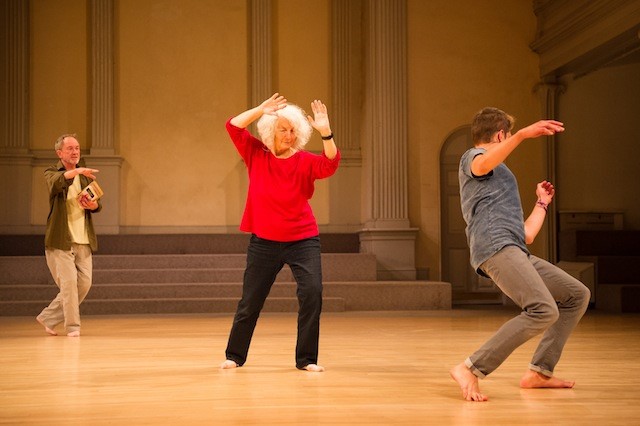Simone Forti: A 78-Year-Old Wonder

Emmaly Wiederholt is a professional dancer and dance writer. She trained at the San Francisco Conservatory of Dance and performed extensively for Malinda LaVelle's Project Thrust. She also started Stance On Dance, an online dance blog with essays, interviews, art, funny tidbits and more. Emmaly is a weekly columnist for Neon Tommy, chronicling her dance class adventures in Los Angeles.

I admit to myself I like watching her more than Gerard.
There’s something about her wispy white hair crowning her frail body that make her stunning. She wears a thin gold chain that dangles delicately off her neck. As she leans over her notebook, she begins to recite her handwritten poetry.
ALSO SEE: Go Gaga in in Your Dance Class
Later over the telephone, I ask Forti when she started writing. She says: “Well, I do have that book that came out in 1974 'Handbook in Motion.' That’s the first time I published anything. Although I write journals and poetry, I didn’t think of myself as a writer until 1974.”
"Does your dancing and writing influence one another?" I ask.
“They definitely feed one another," Forti says. "In my dancing, I always have something I’m exploring. I went through several years of exploring animal movements, mainly through observations in the zoo and building a movement vocabulary through trying those movements on my own body. Now I’m tracking the news and thinking about the world and having my movement be influenced by those thoughts. It’s a little harder to talk about, but I think often we make mental models of thoughts about the world, and I think that my body goes into those mental models of energy, of timing, of shape, of tension. [I think] What I’m after is an openness between what I know in my bones and these mental models that I conjure -- a discourse between that and my verbal intelligence.”
Why am I so hung up on her writing? The answer is simple: I am a dancer and a writer myself, and I’m always excited by the prospect of overlap. I, too, am looking for a discourse between what I know in my bones and my verbal intelligence.
Forti, of course, is years ahead of me. She has been doing this for a lifetime. Born in Italy in 1935, she grew up in Los Angeles. She began pursuing dance seriously at the relatively late age of 21 under the guidance of San Francisco Bay Area’s Anna Halprin. Forti was drawn to Halprin’s improvisational approach, and to this day she considers Halprin to be one of her most pivotal teachers.
ALSO SEE: The La-La World of Reid Olson’s Ballet Class
Upon moving to New York, she took choreographic composition classes from musician Robert Ellis Dunn at the Merce Cunningham Studio. Dunn’s class appropriated composer John Cage’s musical techniques and applied them to dance. He is commonly thought to be the impetus for the postmodern dance movement and the Judson Church era. Forti's contemporaries include such giants as Trisha Brown, Yvonne Rainer, Steve Paxton and Deborah Hay.
Inspired by new ways of thinking about movement, Forti began making her own work in 1960, launching a career that would include experimentation in improvisation, pedestrian gestures, games, animalistic movement, incorporation of speech into choreography and collaborations with several musicians.
Forti has never stopped experimenting with her choreographic voice. “That Fish is Broke” is part of her exploration into the news and is a collaboration with Gerard and improvisational theater veteran Terrence Luke Johnson. Not only has she choreographed the piece, but she’s also performing in it.
“I am able to dance in my own work because I do improvisation -- I can keep working within the range I can do. I don’t see any reason to stop dancing,” she says.
The dance is simple: improvised words and movements. The performers joust. They discuss fish, ants and antlers. They forget the words they’re looking for. Motion seems an extension of conversation. And then motion becomes the conversation itself.
In all my experience with dance, I’ve never seen a young man and an older woman dance together, but Gerard and Forti do. It’s a beautiful scene as they banter back and forth with speech and movement, his eager physicality juxtaposing with her delicacy. But at the same time, Gerard’s youth and masculinity seem audacious next to her unassailable presence.
This contrast between youth and age makes me ponder the process of accumulating a life’s worth of work. I ask Forti if she ever revisits her earlier writings or dances.
“I’m having to go back and revisit them now because I’m involved with archiving my work," Forti says. "I’m having to look at videos that makes me think of the different dancing, pieces and collaborations over the years. I wouldn’t have chosen to focus on archiving. I’d rather just make stuff, but I do recognize the responsibility. If I step aside and step out of myself for a moment and look at the work, I recognize it’s a resource and something valuable that should be taken care of."
Yes, Simone Forti, your work should be taken care of. From your beautiful poetry to your choreographic work spanning the past 50 years, it is indeed an incredibly valuable resource. From the historian’s point of view, this is true; but more importantly, because of my love affair with words and dance, it’s especially true. Like a lighthouse, you illuminate what is possible; I hope to one day be 78 and still be dancing and writing.
Reach Columnist Emmaly Wiederholt here or follow her on Twitter here.



